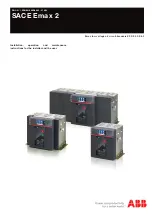
Effective 2/2/2001
Page 20
I.L. 70C1037H03
4.3 Long Delay Time Setting
There are 8 available Long Delay Time Settings, as
illustrated in Figure 4.2, ranging from 2 to 24 seconds.
These settings are the total clearing times when the
current value equals 6 times (
I
r).
Figure 4.2 Long Delay Time Settings
NOTE:
In addition to the standard Long Delay Protection
Element, trip units also have a Long Time Memory (LTM)
function, which protects load circuits from the effects of
repeated overload conditions. If a breaker is reclosed soon
after a Long Delay Trip, and the current again exceeds the
Long Delay Setting, (
I
r), the LTM automatically reduces
the time to trip to allow for the fact that the load circuit
temperature is already higher than normal because of the
prior overload condition. Each time the overload condition
is repeated, the LTM causes the breaker to trip in a
progressively shorter time. When the load current returns
to normal, the LTM begins to reset; after about 10 minutes
it will have reset fully, so the next Long Delay trip time will
again correspond to the Setting value.
NOTE:
In certain applications, it may be desirable to
disable the LTM function. Open the test port located at the
lower left-hand front of the trip unit and use small, long-
nose pliers to move the LTM jumper inside the test port
(see Figure 4.3) to its Inactive position. (The LTM function
can be enabled again at any time by moving the LTM
jumper back to its original Active position.)
4.0 PROTECTION SETTINGS
4.1 General
Before placing any circuit breaker in operation, set each
trip unit protection setting to the values specified by the
engineer responsible for the installation. The number of
settings that must be made is determined by the type of
protection supplied by each unit, as illustrated in Figures
3.2 through 3.9. Each setting is made by turning a rotary
switch, using a small screwdriver. The selected setting for
each adjustment appears on the trip unit label.
The installed rating plug must match the current sensors
which establish the maximum continuous current rating of
the circuit breaker (
I
n). Instantaneous and ground current
settings are defined in multiples of (
I
n).
To illustrate the effect of each protection curve setting,
simulated time-current curves are pictured on the face of
the trip unit. Each rotary switch is located nearest the
portion of the simulated time-current curve that it controls.
Should an automatic trip occur (as a result of the current
exceeding the pre-selected value), the LED in the appropri-
ate segment of the simulated time-current curve will light
red, indicating the reason for the trip.
The available settings, along with the effects of changing
the settings, are given in Figures 4.1 through 4.8. Sample
settings are represented in boxes 2.
4.2 Long Delay Current Setting
There are eight available Long Delay Settings, as illus-
trated in Figure 4.1. Each setting, called (
I
r), is expressed
as a multiple (ranging from .4 to 1) of the current (
I
n). The
nominal current pickup value is 110% of the setting.
NOTE:
(
I
r) is also the basis for the Short Delay Current
Setting
(See Section 4.4).
Figure 4.1 Long Delay Current Settings
















































